- Images
- Blog
- Tools
- Questar
- The Questar telescope
- Questar resource links
- Search for Questar info
- 172mm Focal Reducer
- Afocal adapter for point and shoot camera
- Camera adapter lengths
- Camera adapter threading
- Camera connection
- Camera focusing
- Custom counterweight
- Drift Alignment Joy
- Finder Eyepiece Compatibility
- The Questar Moon 1981
- Questar Powerguide II Battery Life
- Questar Zone, How to Service Videos
- Red Dot finder mount for Questar
- Questar Viewing Table
- Wedge mounts
- White light solar filters comparison
- How to
- Get started in astronomy
- Astro RaspberryPi Camera and kin, the ASIAir and StellarMate
- Blind Smart-phone Equatorial Wedge or GEM Polar Alignment
- Camera phone adapter
- Celestron FirstScope with equatorial tripod mount
- Coat Pocket Astrophotography
- Day-lapse Images of Earthshine on the Crescent Moon
- Dobsonian Carrying Case
- DSO Astrophotography without a Telescope
- DSO imaging without a star tracker
- Estimating image resolution
- Lunar Eclipse Photography
- Moon photography - a dozen ways to shoot the Moon
- Meteor shower photography & planning
- Matching image sensor size to telescope resolution
- Narrow band imaging with color cameras
- Planetary Image Workflow
- Print and Display Astrophotography
- Observing
- Events
- More
- About
- Contact
Starter telescopes for beginners
A good telescope requires costly precision optical and mechanical parts. First time telescope buyers are easily overwhelmed by the variety of telescopes, but usually have something in mind like one of the telescopes below:
Don't buy a telescope that looks like these ...
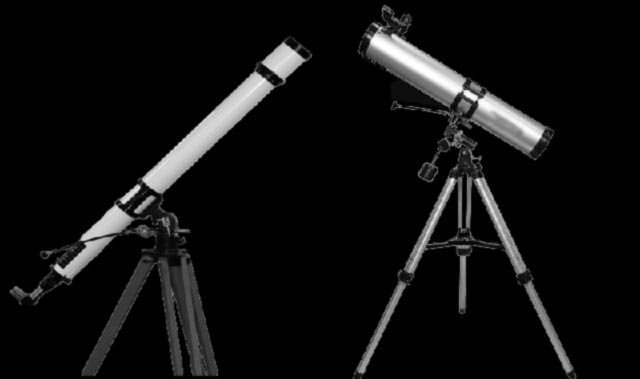
Modern manufactures have become very adapt at imitating these classic telescope forms at low prices. The problem is that these telescopes do not perform nearly as well as similar looking telescopes from 50 years ago. A more modern design, the Dobsonian, is easier to use and gives steadier, brighter, and clearer views. Sky & Telescope has their own take on Hobby Killers: What Telescopes Not to Buy. I'll focus here not only on what to buy, but what to look for in any quality telescope.
You will quickly find many different kinds of telescopes with more choice as you spend more. Do you want to observe planets, deep sky objects, or both? Do you want to observe visually or try astrophotography? Will you need to travel with your scope? A first time buyer doesn't have much experience for choosing. Different kinds of observing work best with different telescopes.
The good news is that you can find reasonably priced telescopes that will let you see many kinds of celestial objects in the price range of $50 to $400 new. These telescopes are far better than any that Galileo used!
Second hand expect to save 1/3 to 1/2 of new prices. An easy to use starter scope may be all you ever want. If you discover interests that require something more, a good starter scope can still be a good investment, as an easy to use grab and go telescope. A starter scope gives you the chance to explore your own preferences and the experience to make a better choice in a larger more complex telescope. I'm an astrophotographer and I often set up an additional telescope or two for myself and guests to observe visually while I'm imaging.
The two most important parts of any telescope are:
The Mount
The mount is the most important part of any telescope. Both a mount head, to allow pointing the telescope and a tripod or pier, to hold it off the ground, are required. Typical beginner telescopes average focal length is about 1000 mm and may magnify the image from 50 to 200 times. This makes them very sensitive to wind and vibration. You can't enjoy a telescope when the image is jumping around and it's hard to find and focus on your target. Most of us picture a telescope mounted on a tripod or a pier with an astronomical mount like the ones above. The reality is that a tripod and mount rigid enough to hold even a small telescope steady costs hundreds of dollars. Telescopes sold with traditional mounts at reasonable prices bundle an inferior optical tube on a wobbly mount. A scope like this makes stargazing a chore rather than a pleasure.
An easy way to judge the stability of a telescope on a mount is called the tap test. Focus on a star or distant object during the daytime. Tap the front end of the telescope firmly (but not hard enough to push it away from your target). Your target will twitch and settle down after a while. If your telescope takes longer than a second or two to settle down, a more rigid mount is needed. A while back I swapped a tripod that settled in 2 seconds for one that only took about one second and found that the telescope was much easier to focus.
Equatorial or polar aligned mounts are required for long exposure astrophotography. Mounts, which can hold the weight of a telescope steady enough for astrophotography, cost many times the price of a starter telescope. This is why I recommend camera lens based astrophotography for interested beginners.
Optics - Aperture, Focal Length & Quality
The aperture of any telescope is the diameter of the primary mirror or lens used to gather light. The brightness of targets seen through the telescope increases with the square of aperture. The detail (and useable magnification) of what you see increases linearly with aperture. Bigger is better but becomes expensive quickly. Larger telescopes are heavier and take more time to set up, as a result they often get used much less often.
To see the faintest galaxies, you need to gather lots of light with an optically "fast" telescope, this means a low focal ratio (focal-length/aperture-diameter). A brighter image for faint DSOs requires either a large diameter objective (heavy and expensive) or a short focal length (less magnification, less cost). Many deep sky objects are surprisingly large. A short focal length (< 800mm and a focal ratio of f/7 or less) is a good choice for a beginner interested mainly in deep sky objects. To see detail on the planets, you want a long focal length (> 1000mm) for more magnification. For visual observers. atmospheric turbulence limits the gain in detail resolution for apertures past 150mm or so. With additional lenses (Barlows and focal reducers) the native focal length of a telescope can be changed, but good ones can cost as much as a starter telescope. Starter telescopes usually take a middle ground with apertures from 75 to 200mm and focal lengths of around 1000 mm. If you are mainly interested in viewing planets or deep sky objects, pick a telescope with a suitable aperture and focal length.
Good optical quality gives you pinpoint stars without color aberrations to the edge of your field of view. Budget telescopes and eyepieces are less clear away from the center of view. Eliminating these distortions requires more time and expense in making mirrors and lenses. Look for pinpoint stars without any color ghosts or rainbows over most of the field of view. Reasonably priced refractors will always show some color ghosts around bright objects, reflectors should not. Getting a near perfect image across a wide field of view can be costly. Pointing a beginner telescope so that what you want to see is in the center of view is free! A reflector with a parabolic primary mirror will give sharper views across the full field of view than less expensive spherical mirrors. Refractors require a compound objective lens to avoid color halos on the objects you view. Look for an achromatic doublet refractor to remove most color aberrations. An apochromatic (APO) refractor may use a triplet or quadruplet objective or expensive enhanced dispersion (ED) glass to provide color correction comparable to a reflecting telescope. Refractors without color aberrations cost more than the telescopes I recommend here.
Astrophotography
Many people want a beginner telescope that they can use for astrophotography. You can take afocal images of the moon and bright planets with any telescope. Afocal images are taken with the camera lens at the eyepiece in place of your eye. Without a tracking mount, astrophotography only works with very bright objects.
High quality deep sky images require prime focus astrophotography with a camera body in place of the eyepiece. Newtonian reflecting telescopes often do not have enough back focus range for prime focus photography. Dobsonian mounts are not easily adapted for motorized star tracking. Long exposure images are easiest with motorized equatorial mounts. Refractors, catadioptric (folded optics with lenses and mirrors), and astrograph reflectors are all popular with astrophotographers. These are not good telescopes for beginners because of complexity and cost.
If you are interested in astrophotography, start with some afocal shots of the moon and Jupiter at a telescope eyepiece. It takes practice and a steady hand, but you can take good images this way. For reasonable cost deep sky images it is best to avoid telescopes. A tracking mount for a camera and lens is much more reasonably priced than one that can handle the weight of a telescope. Once you learn the needed low light photography and post processing skills, you can make beautiful astrophotographs without a telescope.
Inexpensive vintage SLR camera telephoto lenses can make great telescopes with a camera. With a budget of less than $1000 you can take some amazing images without a telescope. Find out how in my guide to getting started in astrophotography. You can also read about how to make a simple camera phone adapter that will make taking afocal images with your starter telescope easier.
Nico Carver of Nebula Photos has a good video on YouTube that will tive you a good idea of the range and costs of astrophotography setups as well as the images possible with them: Astrophotography from $100 to $10,000
The starter telescopes I recommend are best for visual observing, because of the high cost of telescope mounts suitable for astrophotography. The one exception is one of the new smart telescopes.
Recommendations
Dobsonian Mount
I recommend a Dobsonian mount for a starter telescope. The Dobsonian mount is held off the ground or table by three short feet making it stable and rigid. No machined metal parts are needed so it is very easy and inexpensive to make. Alt-Az (for altitude-azimuth or "canon" style) mounts like the Dobsonian are easy to use because they move freely in any direction and don't require polar alignment. The single arm variation works well with small table top telescopes. Larger telescopes have the classic Dobsonian mount with support on both sides.
Dobsoinan mounts are not suitable for telescopes that don't have the eyepiece at the top of the tube. This is why they are paired with Newtonian reflecting telescopes.
Newtonian Reflecting Telescope
Reflectors give you more aperture and a brighter image for the price than other kinds of telescopes. Newtonian reflectors with the eyepiece at the top side are easy to use for visual observation. They need occasional alignment for best performance, but this is easy to do. Reflectors do not have the false color halos around bright objects that moderately priced refracting telescopes show.
Aperture: You can find good starter telescopes with from 75mm (3") to 200mm (8") of aperture. A 3" scope will show the moon and planets along with some of the brighter and larger nebula and galaxies well. An 8" scope will show you objects over 2 stellar magnitudes dimmer and the full moon will be too bright to look at for long without a filter!
Focal Length: A faster focal ratio, short focal length telescope (< 700 mm) will give you a wider brighter view. A long focal length (> 1200 mm) gives a narrower field of view, but makes bright objects like planets or the moon can be seen in more detail with a comfortable eyepiece.
For all but the lowest price telescopes, look for a mirror with a parabolic profile. This will give a clearer view off axis than a less expensive spherical mirror.
Eyepieces
Eyepieces are sized by their focal length. The ratio of telescope to eyepiece focal length sets the optical magnification. Additional characteristics like eye relief, exit pupil and apparent field of view can make an eyepiece more or less comfortable to use. Good eye relief is especially important if you will view with eyeglasses on and is hard to find in short focal length eyepieces. Make sure that your telescope will fit an eyepiece with a 1.25" barrel. A better eyepiece is the easiest and best upgrade for most starter telescopes. Modern quality eyepieces use a 1.25" or 2" barrel and not the 0.965" diameter found these days on toy telescopes.
Inexpensive eyepieces (e.g. Hyghens, Kellner, Ramsden) will have color aberrations, narrow fields of view, and less eye relief. Better eyepiece designs (Konig, Orthoscopic, Erfle, Plössl, ...) offer dramatic improvements in quality of view and comfort, but can easily cost many times what a starter telescope costs. Good eyepieces will be made with a metal barrel with optical glass lenses coated to reduce reflections. It's better to get one good eyepiece that is a keeper with your telescope than several that will be headed for the trash bin once they are replaced. Wide field eyepieces (more than 60 degrees apparent field of view) let you see more of the sky in one look are usually expensive and have additional lenses that may reduced contrast.
The most common good quality eyepiece is the Plössl with good value at reasonable prices. They are offered by many makers and may be included with the more expensive starter telescopes. A great first eyepiece is one about 24mm (20 to 28 is fine). A higher power one with about 8mm of focal length is a good 2nd eyepiece, but short focal length Plössls have very little eye relief. Make sure that it has enough eye relief for your comfort. Eventually you may want to add a third eyepiece splitting the difference between the two that you have (around 16mm). You can find good Plössl eyepieces for as little as about $50 new or about half that second hand or in a bargain brand.
Moderately priced eyepieces with a focal length shorter than about 8 mm can be very difficult to use because most have very short eye relief. This means that your eye has to be right up against the lens to see the full view and that you can't be wearing eyeglasses. If your telescope focal length is short and you need more magnification than 8mm will give, a Barlow lens is a good choice. These are used between the eyepiece and the telescope to increase magnification. The ones sometimes included with starter telescopes are usually throw away items. Expect a good Barlow lens to cost as much as an eyepiece. Ultra wide field of view eyepieces with more than the 50 degree apparant field of view of a Plössl are usually very expensive. There are now some 68 degree wide field eyepieces from Svbony which have good eye relief even at short focal length, in the $20 to $30 range. Look for ones with coated optical glass and not plastic lenses. Off axis performance isn't great, but they are much better than the eyepieces included with most inexpensive telescopes.
Other accessories
I don't recommend small straight through optical finder telescopes; they are dim and hard to use. The best inexpensive finders are optical reflex finders with illumination from a red L.E.D. They have the advantage of letting you point your telescope without loosing your place in the sky. Straight through telescopic finders are uncomfortable to use. Telescopic finders with the eyepiece at a right angle to the tube are much easier to use, but too costly for a beginner telescope.
Barlow lenses can increase your telescopes effective focal length and focal reducers can increase your field of view. Even good ones trade these effects for reduced image quality. The Barlows bundled in some starter telescopes are very poor quality. Expect a good one to cost as much as a good eyepiece.
If you will be using your telescope away from your own home, a protective case or bag is worthwhile. You can make your own.
Not recommended: electronics, GoTo, bundled cameras
At a moderate price point of less than $400 I do not recommend any electronic features in a starter telescope. Including these items leaves less for quality optics. It is unlikely that the electronic features and mostly plastic drive trains will work well or last very long.
Learning to find your way around the sky yourself is an important skill for a beginner to learn. It's easy to find pretty astro images with little effort on the internet. Automated Go-To or Push-To features that work well can be very helpful in finding dim objects in light polluted urban skies. You may want a good electronic mount eventually, but in a starter telescope you will appreciate the better views and a solid mount that you can get without expensive electronic features.
Sky glow from light pollution can make dim objects difficult to find from near cities. Push-to encoders and electronics can help, without the cost and weight with heavy batteries of a motorized go-to mount. After aligning the telescope, you specify your target and the electronics show you just how to turn the telescope to find your target. There are retrofit kits available for standard Dobsonian mounts. Some larger Dobs are available with push-to pre installed. Smart phone apps are another alternative. Electronic compasses in phones are not accurate enough to precisely locate targets, but when combined with star hopping from a near by bright star, an app can reliably place a target in the eyepiece field of view. See how you can make a simple adapter for an iPhone to turn any manual telescope into a push-to scope with an inexpensive app.
Specific telescopes recommendations
A reflecting telescope on a Dobsonian mount is your only realistic choice in an inexpensive telescope. A tripod alone capable of holding a small telescope steady will run from $100 to $400, that cost has to come out of the optics in an inexpensive scope bundled with a tripod. Inexpensive telescopes with equatorial mounts will bundle a poor quality optical tube along with a poor quality mount. Refractors in this price range will give dim images with color aberrations. Any electronic features will come at the price of optical quality.
The optics of most moderate cost telescopes are made in a couple of factories in China and are of consistently good quality. Dozens of manufactures take these same mirrors and lenses and put their own name on them. The only real differences are the name, colors, and accessories that they are bundled with. The examples below are ones that I have some personal knowledge of. You may find a better deal on something equivalent.
Smart Telescopes
Smart telescopes are GoTo telescopes on steroids. They often don't have an eyepiece, because they are intended for eletronic viewing or astrophotography. Alignment is completely automated. This sounds ideal for a beginner, but these have been expensive, at prices well beyond what it makes sense to recommend to a beginner. More advanced astrophotogaphers can put together a kit that takes a bit more effort to set up, but can take much more detailed images. This has changed recently with a couple of vendors introducing smart telescopes at prices that make sense for a beginner. These scopes can find dim targets using plate solving and use narrow band filters which elimiate almost all light pollution for colorful emission nebula targets. Because of this a city bound astronomer can "see" many more targets with one of these smart scopses than even a large Dobsonian. See below for recommondations for smart scopes.
$50+ - Mini Tabletop Single Arm Dobsonian Reflecting Telescope
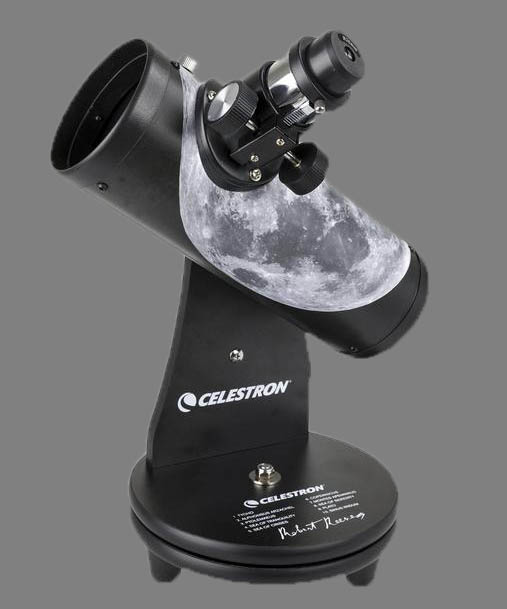
The Celestron 76mm FirstScope is a table top single arm mini-Dobsonian telescope that is very inexpensive at about $50 list. It's occasionally less than $40 on sale. You will probably want to replace the low quality included eyepieces. It has a spherical mirror which reduces off axis image quality, but still gives very nice views at a very low price.
The Orion FunScope 76mm TableTob Reflector is a similar telescope with a spherical primary mirror at a similar price. Meade's LightBridge Mini 114 mm sells for about $150 and has a parabolic mirror! Meade's EclipseView 82/300 Dob runs around $140 and is includes support for solar viewing..
Replacing the included eyepieces is an easy and significant upgrade. For about $25 second hand, a 25mm Plössl like the Orion Serius line makes a great main eyepiece for the FirstScope. 25mm is about the longest focal length that you can use in a small reflector like this without having a noticeable mirror shadow. The included 4mm eyepiece relief is much too short to be useful. I've found SVBONY 68 degree ultra wide long eye relief eyepieces at 15 and 6 mm focal lengths which are a good match for this telescope for a similar price on eBay. Off axis aberrations are noticeable, but acceptable at this price.
Like all Dobs, an inexpensive Alt-Az mount allows the manufacturer to provide a solid, easy to use, mount, along with fairly good optics, at a reasonable cost. A table top mount limits use to where a table is available. If you have a sturdy tripod it's easy to make an adapter that can mount the FirstScope on a camera tripod in either an Alt-Az or an equatorial orientation for easier star tracking. I've written a guide to making a simple adapter.
$200+ - Tabletop Single Arm Dobsonian Reflecting Telescope
At this price level you will find larger aperture parabolic primary mirrors standard on most scopes. These will have brighter images that show less distortion at the edges of the field of view than less expensive spherical mirrors. The included eyepieces will get you started, but upgrading them is easy. Upgraded eyepieces will give you a wider, clearer, more comfortable views.
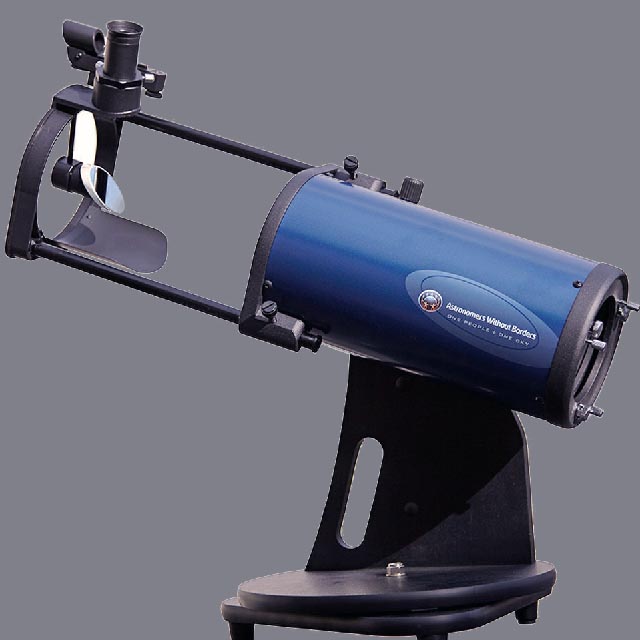
A good step up from the FirstScope is the larger table top Astronomers Without Borders OneSky telescope. The OneSky gives brighter higher quality images than the FirstScope while still being more portable than a full size Dobsonian telescope. Read the Sky & Telescope review.
The Orion StarBlast 4.5" Astro Reflector used by the very successful Library Telescope Program is another great choice.
$300-400 - 6 to 8" full size Dobsonian Telescope
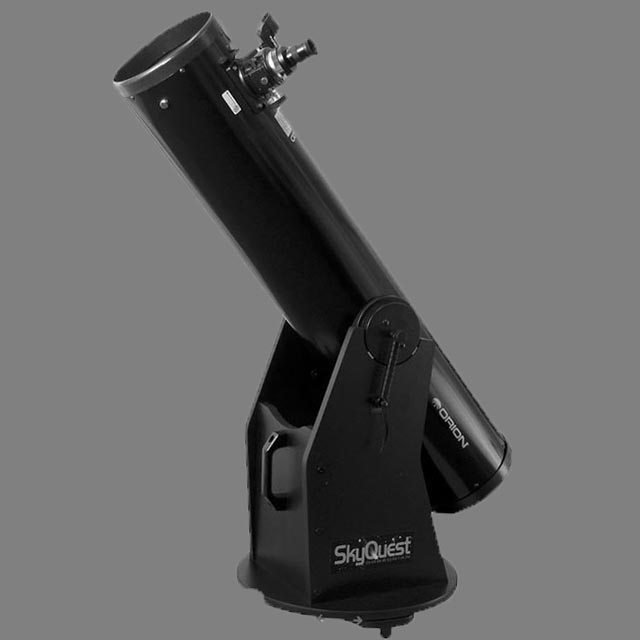
A full size Dobsonian with a 6 to 8" primary mirror is an excellent starter telescope. They are well suited to both solar system and deep sky visual observation. There are many vendors (Celestron, Explore Scientific, Meade, SkyWatcher, ...) selling full size Dobsonian telescopes with high quality Chinese optics in the $300 to $400 range. The incremental cost of an 8" Dob is well worth it. They are almost as easy to move around as a 6" and give images that are almost twice as bright. My first good telescope was a second hand Orion 8" XT-8 200mm Dobsonian.
$400+ Smart Telescopes
Electronics and software for computational astophotography are beginning to revolutionize amateure astronomy. The first of these scopes that make sense as a starter telescope were introduced in 2023. They are entirely automated and can show a beginner more targets, in a bright city sky, than a moderate size Dobsonian of the same cost. In addition they are much smaller and more portable than a Dob. The ZWO Seestar S50 All-in-one Smart Telescope includes everything you need including a white light solar filter and a dual narrow band O3 Ha filter for just under $500. If you will be doing most of your observing under city lights and would like social media quality astrophotos of what you see, this may be a good choice for you.
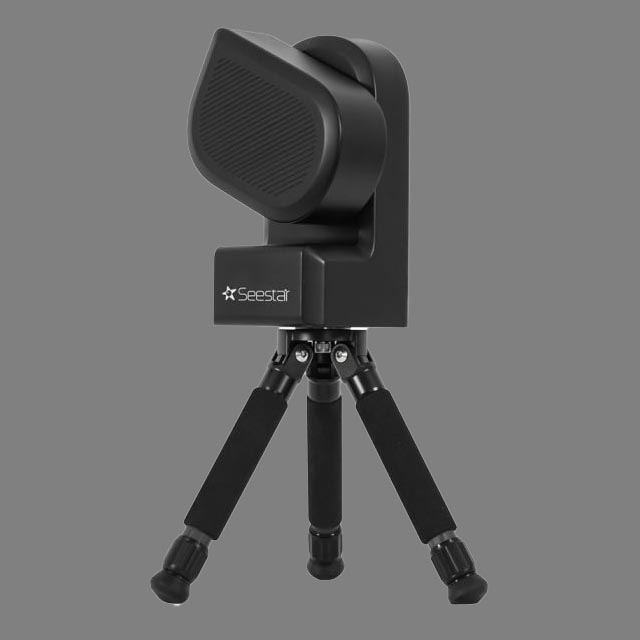
Brands
Except for low volume custom telescopes (i.e. very expensive) most telescopes are made by a few factories in China. These companies are not familiar names to consumers: Guan Sheng Optical (GSO), Kunming United Optics, Ningbo Sunny Electronic, Synta, ... These factories all produce high quality telescopes. Chances are good that any telescope from most familiar consumer brand: Bresser, Celestron, Explore Scientific, Meade, Orion, Sky Watcher, etc. was made by one of these Chinese makers. Some of these brands are now owned by those manufacturers.
Don't be too concerned with the specific brand of a telescope. The type of scope is more important. Dobsonians are particulary good values for beginners, If you pay more, an achromatic or apochromatic refractor, a Newtonian on a quality equatorial mount, or a catadiaptric scope on a fork mount may be the right scope for you. There are some problematic types of telescopes, still sold by many well known brands, which should be avoided, e.g. Bird-Jones short tube reflectors, singlet refractors, anything on an inexpensive light-weight equatorial mount. You can often find several versions of the same telescope differing only in name, paint, and accessories from different consumer brands. When this happens you can choose based on availability, price, and accessories.
More about choosing a telescope
You will find nearly as many different opinions on beginner telescopes as there are amateur astronomers. Try out some at a local star party. Google is your friend for finding other opinions. You can check out other telescopes that I own and enjoy. For more comprehensive information on choosing a telescope, Starizona's telescope tutorials are excellent and include a guide for choosing a telescope. In book form, The Backyard Astronomer's Guide is an excellent source of information on choosing and using equipment for amateur astronomy. They have an excellent guide for beginner telescopes below $1000 which includes some refracting telescopes: The Best Beginner Telescopes (under $1000). Trevor Jones of AstroBackyard has a great take on Buying Your First TELESCOPE? Here's What I'd Do!
Content created: 2019-03-19 and last modified: 2023-10-04
Comments
![]() Submit comments or questions about this page.
Submit comments or questions about this page.
By submitting a comment, you agree that: it may be included here in whole or part, attributed to you, and its content is subject to the site wide Creative Commons licensing.

How to
Starter telescopes for beginners
Getting started in astrophotography?
Choose & setup a camera for astrophotography
Astro RaspberryPi Camera and kin, the ASIAir and StellarMate
Blind Smart-phone Equatorial Wedge or GEM Polar Alignment
Celestron FirstScope with equatorial tripod mount
Day-lapse Images of Earthshine on the Crescent Moon
DSO Astrophotography without a Telescope
DSO imaging without a star tracker
Overview & equipment for lunar eclipse photography
Framing and tracking a lunar eclipse
Moon photography - a dozen ways to shoot the Moon
Meteor shower photography & planning
Matching image sensor size to telescope resolution
Narrow band imaging with color cameras
Print and Display Astrophotography


 Lunar Eclipse Photography
Lunar Eclipse Photography